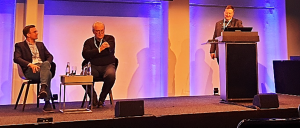 At the joint congress of the German national societies for neurology (DGN), neuropediatrics and neuropathology, with more than 5000 participants (November 1st-5th, 2022), we organized a 90 minutes symposium dedicated to VPS13 research. Nine speakers reviewed “Recent developments in bulk lipid transfer and the so-called ’neuroacanthocytosis’ syndromes”.
At the joint congress of the German national societies for neurology (DGN), neuropediatrics and neuropathology, with more than 5000 participants (November 1st-5th, 2022), we organized a 90 minutes symposium dedicated to VPS13 research. Nine speakers reviewed “Recent developments in bulk lipid transfer and the so-called ’neuroacanthocytosis’ syndromes”.
Only quite recently, location and function of the members of a hitherto little-known protein family (VPS13 A through D) were unraveled. Located at contact sites of membranes of different cell organelles, these proteins act as conduits for non-vesicular lipid transfer. Deficiency of these proteins likely causes alterations of membrane lipid dynamics. The corresponding human genes lead to hereditary neurological disease, such as chorea-acanthocytosis (VPS13 A disease), Cohen syndrome (VPS13B disease), familial parkinsonism with Lewy bodies (VPS13C disease) or various ataxic conditions (VPS13D disease, earlier names: SCAR4, SCA24, or SCASI). Because of molecular interaction, the disease spectrum also involves McLeod syndrome (XK disease) and possibly other conditions.
The presenter team consisted of senior and junior clinical and basic scientists. Bernhard Landwehrmeyer from Ulm University by introduction highlighted possible connections with Huntington’s Disease (HD). While we subsequently presented a bench to bedside and vice versa approach to VPS13A and XK disease, our invited speakers covered additional aspects of the lipid dynamics at membrane contact sites in neurodegenerative diseases (D. Großmann, Rostock), Cohen syndrome (W. Seifert, Berlin) as well as clinical spectrum and treatment by deep brain stimulation in VPS13D-associated disease (N. Brüggemann and M. Pauly, Lübeck). Current experimental work from the Rostock group was covered by A. Spranger who presented lipidomics data from VPS13A disease red blood cells. At the final day of “Neuroweek” our session was mentioned in the movement disorders highlights session (B. Balint, Zurich) because of the importance of a novel pathomechanism that eventually may translate to more prevalent diseases such as Parkinson´s disease and HD.
We are grateful to the DGN scientific board for recognizing this future perspective by including our symposium in the program. The local audience, albeit small (approximately 50), was select and the hybrid format of the congress, including the availability of recordings, will allow for a much wider impact of our symposium.
Article photo shows Chairs Kevin Peikert (left) and Adrian Danek (middle) discuss with Bernhard Landwehrmeyer (right) who introduced VPS13 related research in relation to future insights into Huntington’s Disease.